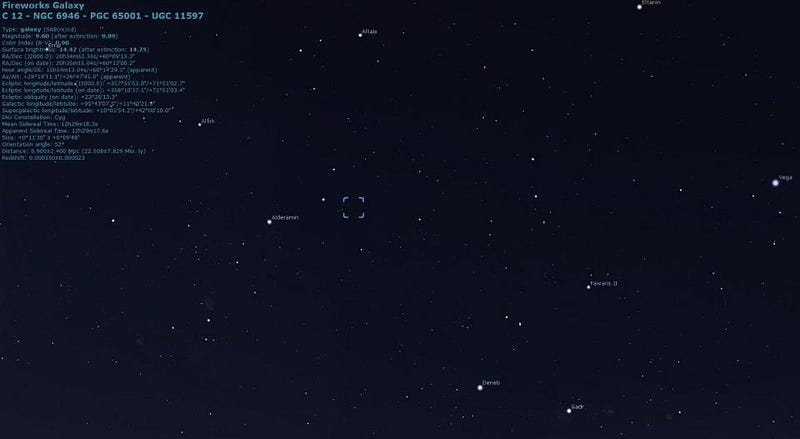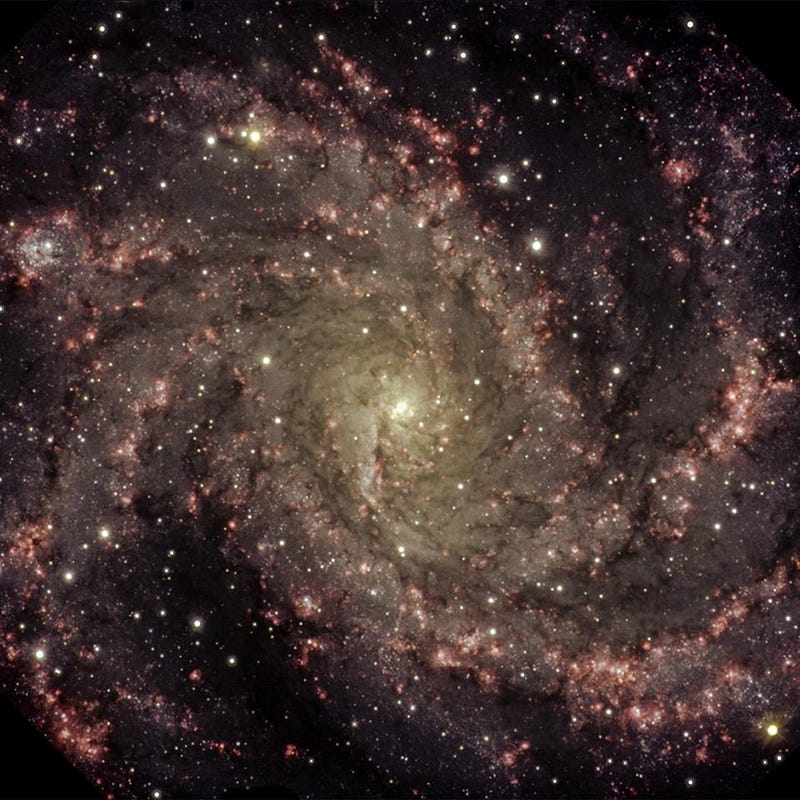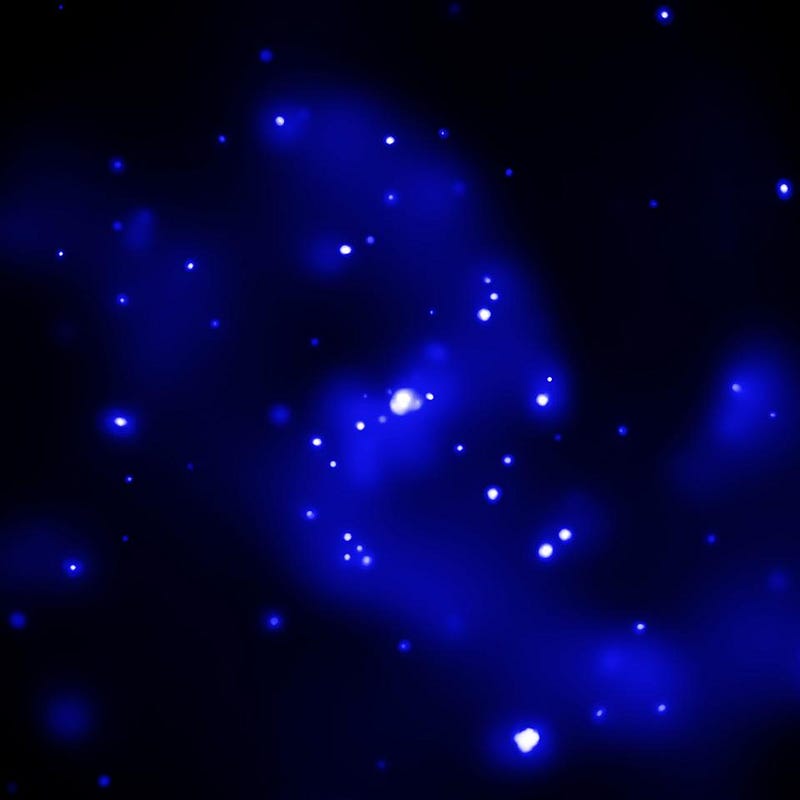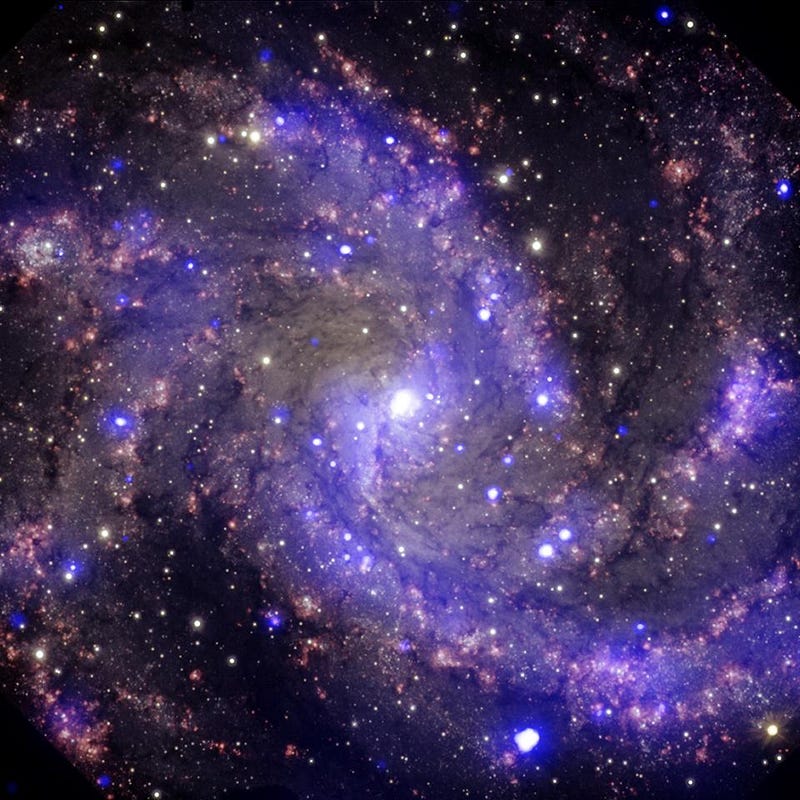Closest supernova in years brings cosmic fireworks to Earth’s skies

The aptly named ‘Fireworks galaxy’ just had its tenth supernova in the past century, setting a record. Learn how to see it!
“When a massive star explodes at the end of its life, the explosion dispenses different elements-helium, carbon, oxygen, iron, nickel-across the universe, scattering stardust. That stardust now makes up the planets, including ours.”
–Michelle Cuevas
After burning bright for millions of years, the brightest stars of all are destined to explode in one final blaze of glory: a supernova. Capable of shining as bright as many billions of stars put together, the light from a single outburst can be seen with the naked eye if it occurs in our own galaxy, and through a modest telescope from even tens of millions of light years away. On May 14th, a brand new supernova was discovered just 22 million light years away in a prolific object known as the Fireworks galaxy, making it the closest supernova to grace the skies in three years. With warm weather and summer approaching, this is the best chance you’ll likely have to see one for yourself all year.

When a star is born, it’s destined to shine brightly under the power of its own internal, nuclear reaction for anywhere from millions to trillions of years. But the most massive stars have a uniquely spectacular fate in store as their destiny: after burning through all the fusible material in its central region, its core will collapse under its own gravity. With radiation and even the pressure of the atoms and atomic nuclei themselves unable to resist the intense forces at play, the core implodes, triggering a runaway fusion reaction. The result is a Type II supernova explosion, which occurs only once per century in a galaxy like the Milky Way.

But in a nearby spiral galaxy that has only half the stars of our Milky Way, these cosmic fireworks occur ten times as frequently. In fact, the galaxy in question, NGC 6946, is nicknamed the Fireworks galaxy for exactly this reason. Located just 22 million light years away, on the border of the constellations Cygnus and Cepheus, an amateur astronomer named Patrick Wiggins discovered a new point of light on May 14th where none had been seen previously, including just two days prior, on May 12th.

Follow-up observations confirmed that this is, in fact, a Type II supernova, one that continues to brighten as the days pass by. This very region of the galaxy happened to be previously imaged by the Hubble Space Telescope, which confirms that there was a progenitor star there, faint but clearly visible, despite the incredible cosmic distance separating us. It’s a spectacular find, and one you can see with yourself through a backyard telescope, so long as you know where to look.

The bright stars Vega and Deneb make up two-thirds of the Summer Triangle, which begins rising in the northeast skies after sunset as summer approaches. Moving away from Deneb in the east and heading towards Polaris, the north star, you’ll encounter the brightest star in Cepheus: Alderamin. If you then trace an imaginary line back towards Vega, the unmistakably bright, blue star you started at back at the beginning, and move about the width of three fingers held at arm’s length, you’ll want to point your telescope there.

A bright star cluster, NGC 6939 (top right, above) and a faint galaxy, NGC 6946 (lower left, above) should appear in the same frame. If you can see the bright “star” located at about the 1 o’clock position of the Fireworks galaxy, that’s no star at all; that’s the latest firework! What you’re seeing is the tenth supernova discovered in the Fireworks galaxy since 1917, where the first one was discovered exactly 100 years ago. No other galaxy has had as many supernovae over this period, which might surprise you, considering that it’s less than a third the extent of the Milky Way.

Size isn’t everything, though! The key to a supernova factory is to have formed a large number of massive stars very recently. In almost every case, the place to look for that is inside an incredibly large star-forming region. When giant clouds of molecular gas collapse, triggered by a supernova, collision, or a major gravitational merger, large amounts of stars form. If the region is massive enough, a huge number of high-mass stars form as well. In the case of this galaxy, practically the entire thing has become a star-forming region.

Galaxies exhibiting a huge rate of star formation throughout are known as starburst galaxies, and are usually triggered by a major merger or galactic interaction. The pink regions seen throughout, above, are indicative of new and current star formation, and help explain why Type II supernovae are so common in this galaxy. With 10 supernovae in the past century, including four already in the new millennium, you’d expect to see a large number of X-ray sources as a result of these cosmic fireworks.

Even from 22 million light years away, the Chandra X-ray observatory can see exactly that. The gas within the spiral arms is heated to such a degree that there’s a diffuse glow extending throughout the star-forming portion, but it’s the bright point sources that are most interesting. Representing both active black holes and recent supernova remnants, this data revealed three of the oldest supernovas ever detected in X-rays. When you combine the optical and X-ray images, you can see just what makes this galaxy so spectacular.

Cosmic fireworks like these don’t truly happen at random; they are clustered in time and space around the most massive, intense star-forming regions of all. You can’t have a bigger star-forming region than one that includes the entire galaxy, and the sweeping, grand, irregular arms of the Fireworks galaxy are as good as they come. Based on what we see, we expect this elevated rate to continue for more than a million years. Keep an eye on this galaxy for the appearance of a “new star,” and if you find one, you just might discover the Universe’s newest supernova!
Ethan Siegel is the author of Beyond the Galaxy and Treknology. You can pre-order his third book, currently in development: the Encyclopaedia Cosmologica.





